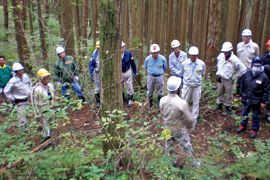The Mitsui & Co. Environment Fund
Introduction to Grant Projects
Tosa no Mori Kyuuen-tai
Establishing the jibatsu (self-harvesting) forestry approach and spreading the practice throughout Japan so that projects employing 500,000 people can be created —Establish the jibatsu forestry style and apply Kochi Prefecture's J-VER method nationwide—
Activity grant
- Project Description
The purpose of the project is to take the jibatsu forestry method that is effective in forestry, forestry regeneration and the rehabilitation of rural villages and establish it as a specific model that can suit a location. In specific terms, this project will adapt the methods of jibatsu forestry (where forestry workers harvest wood by themselves, mainly under individual or family owned management) to local forestry conditions and put it into actual practice in various regions of Japan. Explanatory meetings, coordination and technical training will be provided by Tosa no Mori to those regions collaborating in this project. In addition, the potential for the application of the Japan Verified Emission Reduction of Kochi Prefecture method (Kochi-ken J-VER) will be assessed, with the objective of stable jibatsu forestry management. Furthermore, the project aims to spread this jibatsu forestry method throughout Japan, to create some 500,000 forestry jobs all over Japan.
- Fields
- Preservation of surface soil and forests
- Grant year
- FY2011 Activity Grants
- Grant term
- 3 years
April 2012 - March 2015
- Grant amount
- 11,095,000 yen
- Activity region
- Throughout Kochi Prefecture; Outsuchi-chou, Iwaizumi-chou and Morioka-shi, Iwate Prefecture; the areas surrounding Minamisanriku-chou in Miyagi Prefecture; Ena-shi in Gifu Prefecture; Bungouoono-shi in Oita Prefecture and other locations, Japan

Overview of the Organization

- Representative
- Masami Kataoka, Director
- Establishment
- 2003
- Establishment Purpose
- The NPO Tosa no Mori Kyuuen-tai ("Tosa") is taking back the forestry practices that used to be common-sense years ago, such as "manage your own forest by yourself" and "if you can't manage by yourself, then get the local community to help you." Tosa's philosophy is to resurrect and apply small-scale jibatsu forestry (family forestry). Rather than developing forest volunteer activities separately from forestry, Tosa wants to position jibatsu forestry as an entry point to forestry and expand its frontage to rural villagers, urban residents, and create a form of forestry that is easy for people to enter. Tosa wants to spread the jibatsu forestry method and increase levels of local employment to help revive forests, local forestry, and rural villages.
- Main areas of project activity
- Kochi Prefecture: Agawa-gun, Ino-chou; Takaoka-gun, Hidaka-mura; Niyodogawa-chou; Tosa-gun, Tosa-chou; Nagaoka-gun, Motoyama-chou. Iwate Prefecture: Outuchi-chou. Miyagi Prefecture: Kesennuma-shi, Manamisanriku-chou and the surrounding local area
- Staff
- 6 full-time members, 4 part-time members, 64 full members
- Annual operating budget
- 16 million yen in 2009, 80 million yen 2010, 80 million yen in 2011
- WEB site
- http://mori100s.exblog.jp/
- Affiliated organizations
- Kochi Shinrin Kyuuen-tai, NPO Kirikirikoku, NPO Japan Forest Biomass Network
- Main activities
- Show the world that anyone can be involved in jibatsu forestry by having retired people and other members of the general public doing real work in forestry (thinning, uploading, using materials, etc.) on a regular basis. In addition, holding regular training (the development of jibatsu forestry workers) (once a month) to continually train people to do this work. To give this a boost, the project is providing support in various parts of the country for the setting up of a forestry waste collection and transportation system to use wood biomass and is planning local systems (the "Tosa no Mori system") that will integrate these to be set up nationwide. The Tosa no Mori system had begun to spread throughout Japan even before the Great Eastern Japan Earthquake, and is currently starting to be introduced in around 20 locations. In addition, after its establishment, the system can issue a form of local currency called the "Mori ticket" as a means to make direct payments for the preservation of the forest environment. These help invigorate local economies. The project is also offering training in the forest environment, the use of firewood to encourage the use of wood biomass, and forest tourism. The project is centered on Kochi Prefecture and promotes jibatsu forestry which is a simple form of small-scale forestry in which people manage their own forests by themselves without relying on high-performance high-cost machinery. The project also promotes the development of locally self-sustaining circulatory-type forestry involving wood biomass and local currency, that anyone can become involved with.